In the spring, bright tulips delight the eye with its luxurious flowering. But in order for them to bloom in flowerbeds annually, it is necessary to properly care for bulb crops.
An important technique of agricultural technology - digging bulbs after flowering. Experienced gardeners prepare containers in advance, a place to store planting material. Where and how best to store tulip bulbs in winter or until autumn - everyone decides on the basis of their own abilities. It is worth listening to the recommendations of experts on the timing of excavation, the choice of storage locations, microclimate.
Content
Why dig tulip bulbs
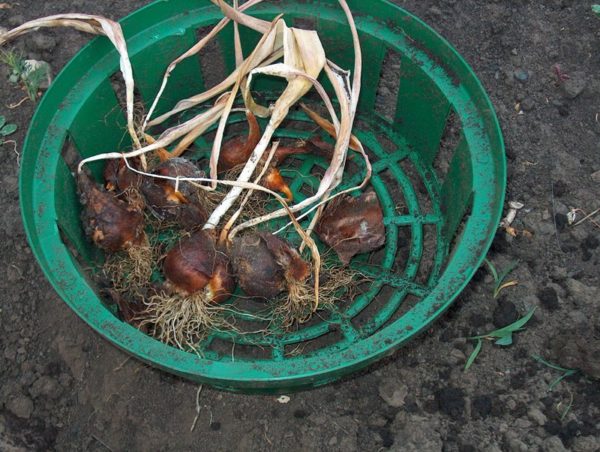
The question of digging bulbous plants is debatable, but still most of the flower growers (including professionals) do not bypass this procedure. Why dig tulips:
- A healthy planting material is selected, sick, weakened bulbs are rejected.
- Every year, the blooming onion “leaves behind an inheritance - a substitute bulb and children. The nest grows, without digging up the tulips go to the depth, become smaller, degenerate.
- Heat-loving plants in the soil may not have enough heat. “Overseas” hybrids and varieties that are not adapted to the climate of Russia are especially affected. As a result, varietal characters are lost, some beautiful parrot or fringed tulips produce buds that do not correspond to the originally laid down properties.
- In the rainy and cool summer season, the risk of rotting bulbs in the soil is great. During storage, it is easier to create the necessary conditions, to monitor the condition of planting material.
- Without digging, plants are often affected by pests and infections. Sick tulips will no longer please bloom in spring.
- Annual digging is a great opportunity to quickly propagate a favorite crop.
Often such tulips in spring give flowers of a completely different color and shape.
| Groups of tulips | Digging frequency | Features of varieties and hybrids |
| Late varieties, fringed, lily-shaped, parrot, Rembrand hybrids, green | Dig out every year | Without digging, varietal characters are lost, plants degenerate |
| Non-Varietal Plants, Darwin Hybrids, Triumph Tulips | Digging every two years | For one season, they do not form full-fledged bulbs, so digging every year is not practical |
| Varieties Kaufman, Foster, Greig | Dig up every 4-5 years | Not prone to degeneration over time. They give a small number of children. |
In flower beds, flowers often grow mixed. Summer plants require fertilizers, watering, and faded tulips at this time build bulbs. Excessive moisture will cause rotting of the nodules. Therefore, it is desirable to remove plants, providing them with optimal storage conditions.
Another argument in favor of excavation is the ability to qualitatively prepare the soil in the flower garden for new plantings.Dig, fertilize, give the soil rest and in the autumn plant the onions on the prepared ridges.
When and how to dig tulip bulbs
No one will tell the exact date of the excavation, since the timing is determined by the climate, the condition of the plants. Early flowering varieties wilt first, about 2-3 weeks after them, middle and late tulips dry out.
Landmark - wilting and yellowing of the leaves of plants after flowering. A change in green to yellow and brown is a signal of the formation of bulbs in the soil. At the same time, it is important to dig up plants in a timely manner - not earlier and not later. It is necessary that the onions ripen and they form brown integumentary scales that protect the contents from wilting and drying out. Defective planting material is poorly stored, does not survive until planting in the fall (not to mention winter storage).
In the southern regions dig up tulips in June, in the middle lane - early July. In rainy summer, flower growers do not expect complete yellowing of the leaves, otherwise the plants in the soil will rot. Remove the onions and then dry thoroughly.
They work according to the timing of flowering tulips. The plants that bloomed in April are dug up earlier, with potter bulbs of May flowers later. Choose a clear, dry day, gently pulling tubers from the soil with a pitchfork.
A shovel does not fit, too many damaged bulbs are obtained. Planting material from dry loose soil is only enough to slightly clear the ground, if the soil is moist, you have to rinse it. After digging, all remaining stems and leaves are cut, specimens are discarded with traces of damage, defects, diseases. You can’t leave them, because from them infections can spread quickly to healthy plants.
Preparing tulips for winter storage
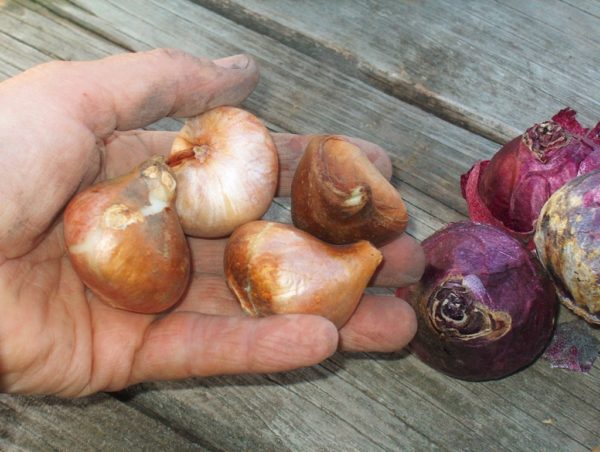
After removing the bulbs, they are carefully sorted, separating the "adults" from the children. For several days, they are placed in boxes for drying, then they are examined again.
The next procedure is disinfection of planting material. Most often, a pink solution of potassium permanganate is used, keeping tulips in it for 30-40 minutes.
After drying, disassemble by size, grades, colors. If there is a lot of planting material, then they work for several days without leaving the bulbs unattended.
Bookmark Tulip Bulbs for Winter Storage: Planning
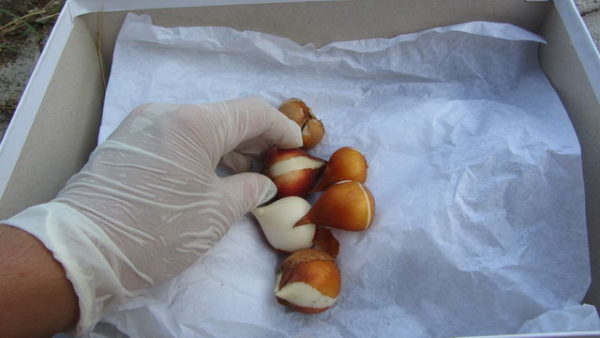
Experienced gardeners have developed their own schemes for the storage of bulbs. First, determine which specimens will go for planting in the fall, and which will be planted in the spring. For the latter, it is necessary to take care of the container and the storage place more carefully, nevertheless they should lie a long winter until spring.
Crumbs of a baby less than one centimeter in diameter are removed, since during storage it is likely that they will dry out. And they will bloom only in two years, not earlier. For winter storage, specimens with a diameter of more than 3-4 cm are selected.
Storage container
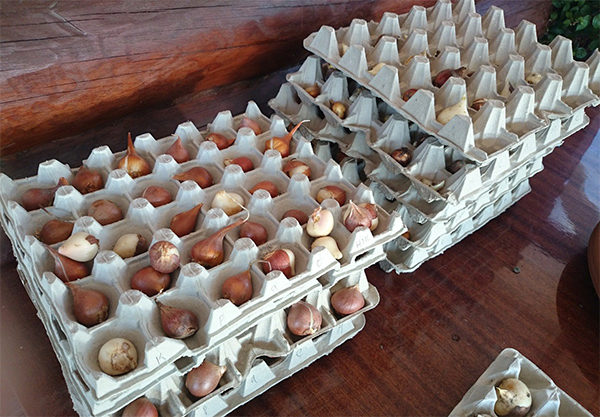
To preserve planting material, prepare containers:
- baskets;
- wooden boxes;
- fruit crates;
- fabric bags.
A good storage option is grates and cardboard egg containers, although some gardeners prefer not to use cardboard containers. It is necessary that tulips placed in boxes or boxes have free access to air.
It is undesirable for the onions to touch, so it is better to shift them with shavings, dry sawdust, and a newspaper. So they are better preserved, do not rot. They are placed in one layer. Can not be used for laying buckets (iron, plastic), tanks, bags made of polyethylene. Glass jars do not fit.
In a city apartment, tulips are well preserved until the fall in old nylon stockings (following the example of onions) or old string bags.
Storage room
To obtain lush flowering in spring, it is required to properly preserve the tulip planting material. Especially carefully choose the place where the onions will be stored. The microclimate of the room, the indicators of temperature, humidity, and light are important. Only observing all the requirements, get healthy planting bulbs.
Requirements:
- lack of dampness;
- the ability to adjust the air temperature;
- darkness (sun rays should not fall into boxes or boxes);
- mandatory preliminary disinfection of the cellar, attic or basement;
- the absence of rodents that can significantly spoil planting material.
Storage locations are selected based on the capabilities of:
- cellar;
- dry basement;
- attic or attic;
- flat;
- special thermal chamber.
Often, tulips are placed on the shelves of the refrigerator. This is permissible if the bulbs are few, but with large batches it is problematic to keep them even until the fall. In addition, according to the rules, the storage temperature is gradually reduced. It is not possible to fulfill this requirement in the refrigerator.
Storage microclimate
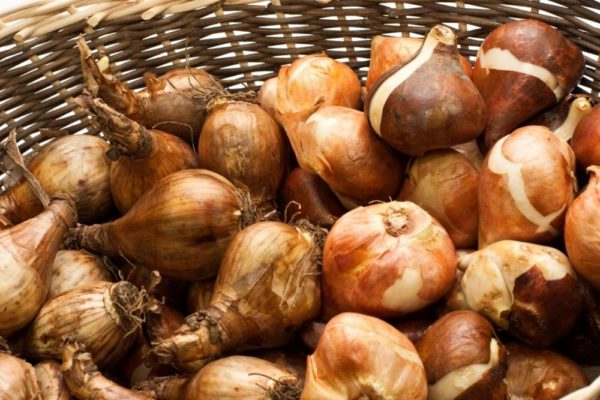
Correct temperature conditions and optimal moisture indicators are the main conditions for maintaining healthy, full onions. Factors affect not only the quality of planting material, but also the flowering of plants, the conservation of varietal traits.
Tulips (especially hybrids) are rather capricious flowers, and any deviation of temperature indicators during storage affects the flowering time, number of peduncles, splendor, shape and shades of buds.
Low humidity is not allowed, otherwise the bulbs will dry. Dampness is dangerous, since mold immediately appears, decay begins, premature germination. Standard rates are 65-70%.
Temperature indicators (for bulbs of autumn planting):
- within thirty days after drying and storage - + 24ºC ... + 25ºC;
- further indicators are reduced by about 5-6 degrees (+ 20ºC);
- after a month they lower the temperature to + 15ºC.
Under these conditions, planting material survives well before autumn plantings. Bulbs are dry, without defects, premature shoots.
Seed Check
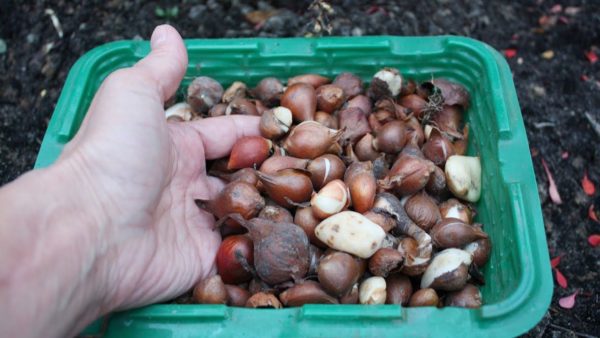
The storage is regularly checked, temperature and humidity indicators are monitored. If the room is dry, install water containers nearby. At high humidity, the room is ventilated, sources of dampness are excluded, bulbs are checked for mold or putrefactive stains.
A regular check will protect the tulips from the spread of a possible infection and prevent the planting material from falling.
Processing after storage
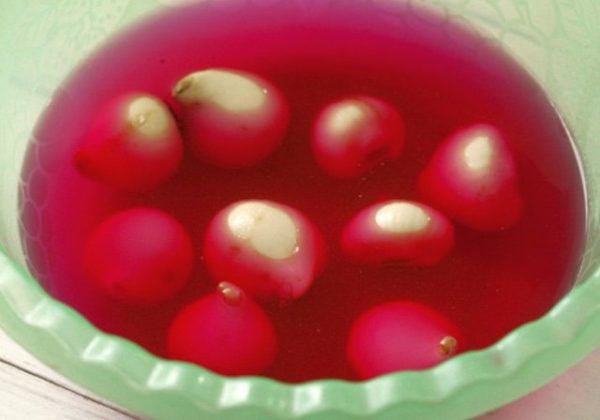
After storage, the tulips are once again calibrated and re-disinfected in any suitable solution (ash, potassium permanganate) before autumn planting. Of the finished preparations for the preparation of a disinfectant solution, use:
- malathion;
- Epin;
- Vitaros;
- Fundazole.
When preparing solutions for disinfection, observe the proportions of the preparations, as well as the time of soaking.
How to properly store tulip bulbs until spring
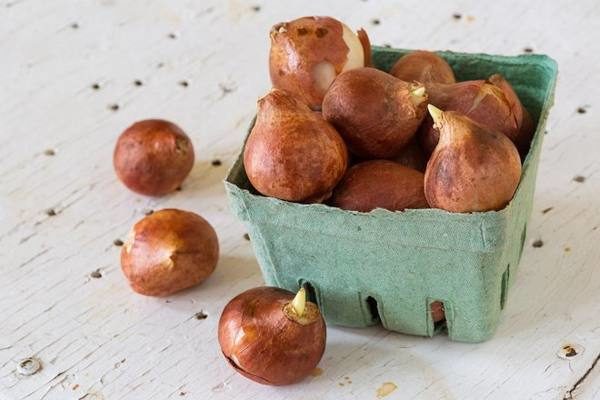
Tulips intended for planting in the fall, lie in containers until mid-September and October. The landing time is determined by the climatic conditions of the area, autumn weather.
Plants planted in autumn root faster and in the spring they flower stalks earlier. But if you do not plant bulbs after the summer, you will have to store them until spring. Unlike summer storage, in winter, the terms increase. Therefore, it is especially important to control the humidity and temperature of the air in the storage.
Storage of planting material in the cellar
Until spring, tulips are well preserved in the cellar. But not laid out in containers, but planted in the ground. To do this, prepare the earth in advance, low boxes.
Garden, pre-steamed earth mixed with peat and river sand is suitable as soil. Instead of sand, vermiculite is added. The soil is poured into boxes and the onions are carefully planted. In this state, they will survive until spring, take root, but will not grow.
In drawers
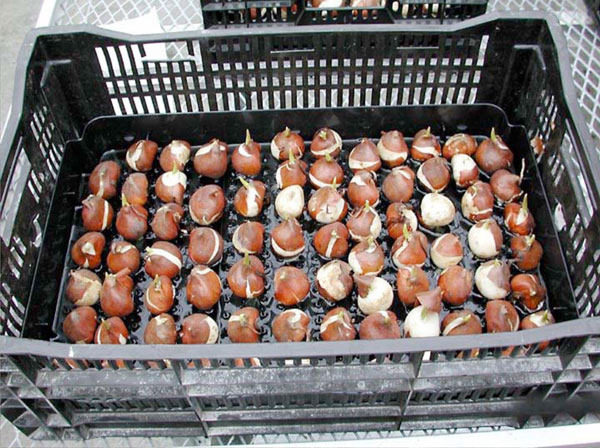
Also stored in winter are bulbous plants in the basement or cool pantry. To do this, prepare containers - wooden boxes with rack walls and a bottom, lay onions in layers, interspersing with sawdust.
To avoid rot, wrapping paper is used instead of sawdust. Each instance is carefully wrapped and laid in place. Storage temperature - up to + 16ºC, humidity - 70%. In dry rooms, it is recommended to moisten the air, otherwise the tubers will dry.
In an apartment
In a city apartment, it is difficult to keep tulip bulbs until spring, so it is advisable to plant plants in the fall whenever possible. If it doesn’t work, then for the winter they arrange a storage on a glazed loggia (temperature + 5ºC ... + 6ºC), in an unheated cool pantry.
The room should be dry, dark. You can not store planting material in an apartment near heating systems, as well as in places where there is no protection against drafts. Once a month, the tulips are inspected, removing all suspicious (with spots or mold) specimens.
In the spring, preserved tulips are planted in boxes, and only then they are determined in the garden.
Fridge
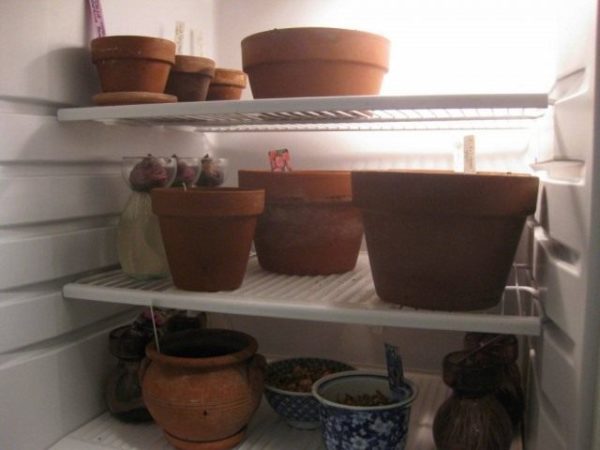
A small amount of planting material is stored in the refrigerator, on the lower shelves. But until spring, it is difficult to maintain stable temperature indicators in the unit, since the doors are constantly opening and closing.
The method is not suitable if there are many colors. A refrigerator for storing large lots is not suitable, so they stock up with a special heat chamber or use storage rooms, loggias.
Heat chamber
If a special unit, a heat chamber, was purchased from the gardener, then the problem of where to determine the onion bulbs in winter is simple. In such devices, an automatic mode for adjusting humidity and temperature indicators is provided. The camera is equipped with a ventilation system, so it is easy to set the desired values for a certain period.
The only minus is the high cost of the device, so most often it is bought by those who grow large quantities of tulips for sale and professionally cultivates onions. By the way, if you want to make such a camera you can do it yourself.
Storage time
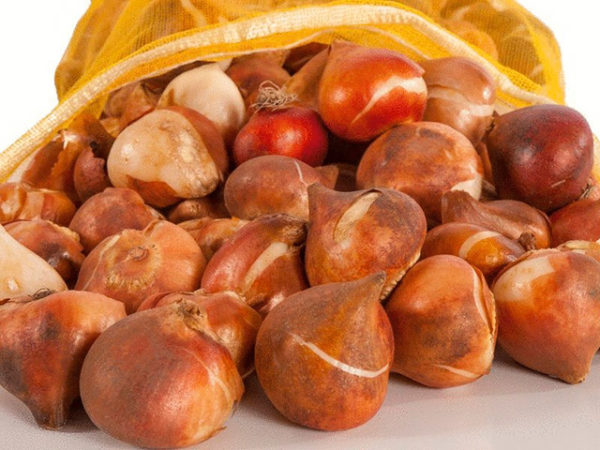
It is difficult to store tulip bulbs in the winter at home. Planting material of these flowers is not suitable for long-term storage. The best thing dig up plants after flowering and store them before the autumn dig. The option with winter storage is suitable only in exceptional cases (for example, bought plants late in the fall and did not have time to plant them before the cold weather). Subject to conditions, onions are well preserved until fall.
If the storage conditions are violated, the bulbs deteriorate. How to determine:
- moisture droplets appeared on the surface of the integumentary scales - a signal of dampness and increased humidity in the room;
- the bulbs wrinkled, became soft - the air in the vault is too dry.
In the first case, household heaters are used for drying, while humidifiers and water containers placed in the storage will help to cope with dryness.
Tulips protect against mice and other rodents not only in flower beds, but also during storage. In cellars, cellars, the premises are sanitized in advance, bait is scattered, and traps are set. To protect tulips from mice, boxes are mounted on shelves, suspended in bags or stockings on hooks to the ceiling. Observing the simple rules of digging and storing tulips, you always manage to get healthy planting material. And this means that in the spring, beloved bulbs in the plots will again please with friendly flowering.

 When and how to plant tulips in autumn in the open ground
When and how to plant tulips in autumn in the open ground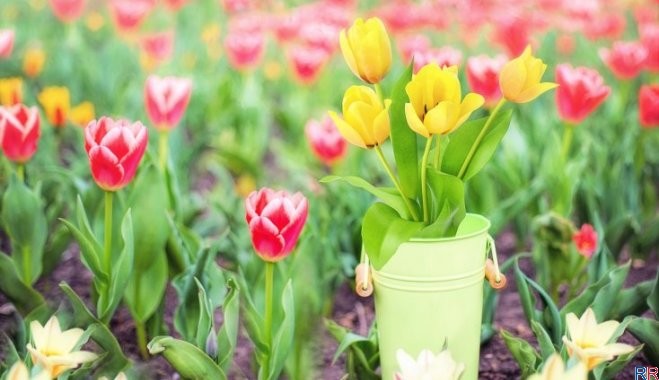 When to dig up tulips after flowering and when to plant again in the ground
When to dig up tulips after flowering and when to plant again in the ground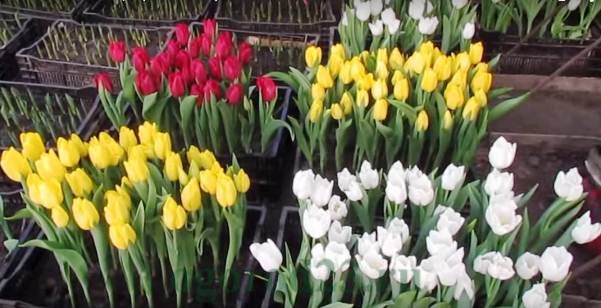 We plant tulips at home on March 8
We plant tulips at home on March 8 How to save tulip bulbs after flowering until next spring
How to save tulip bulbs after flowering until next spring